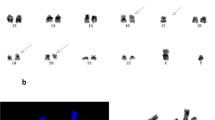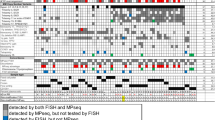Abstract
The MLL gene on chromosome 11 band q23 is frequently involved in chromosome translocations in acute lymphoblastic leukemia and acute myeloid leukemia. The translocation results in the formation of a fusion gene on the derivative 11 chromosome consisting of the 5′ part of the MLL gene and the 3′ part of another gene; already more than 30 different partner chromosome regions have been described. MLL gene rearrangements are generally correlated with a poor prognosis. Therefore the presence of an 11q23 aberration has direct implications for treatment stratification, making early and rapid detection of utmost importance. In this study, we developed a FISH probe set for detection of MLL gene rearrangements according to strict design criteria. The cosmid probes are derived from the flanking regions of the MLL breakpoint region on chromosome 11 and when used in dual colored FISH experiments give rise to a split of the normally colocalizing (fused) signals in case of a translocation. This split signal was observed in seven out of 10 cases with an 11q23 translocation with various partner chromosomes. In the three other cases, a deletion of the 3′ part of the MLL gene, downstream of the breakpoint region was also found. A low false positive value of only 1.7% was obtained for interphase cells in contrast to conventional dual colored FISH where the creation of a fusion signal has cut off values of at least 5–10%. A major advantage of our type of probe set is the application of a single FISH experiment to detect all types of MLL translocations. Moreover, since this cosmid probe set can be used for either interphase or metaphase studies, metaphases are no longer a prerequisite for detecting the presence of an 11q23 translocation. Nevertheless, metaphase FISH with the new probe set is helpful in determining the partner chromosome and therefore may lead to the identification of new partner genes.
This is a preview of subscription content, access via your institution
Access options
Subscribe to this journal
Receive 12 print issues and online access
$259.00 per year
only $21.58 per issue
Buy this article
- Purchase on Springer Link
- Instant access to full article PDF
Prices may be subject to local taxes which are calculated during checkout
Similar content being viewed by others
Author information
Authors and Affiliations
Rights and permissions
About this article
Cite this article
van der Burg, M., Beverloo, H., Langerak, A. et al. Rapid and sensitive detection of all types of MLL gene translocations with a single FISH probe set. Leukemia 13, 2107–2113 (1999). https://doi.org/10.1038/sj.leu.2401595
Received:
Accepted:
Published:
Issue Date:
DOI: https://doi.org/10.1038/sj.leu.2401595
Keywords
This article is cited by
-
The KMT2A recombinome of acute leukemias in 2023
Leukemia (2023)
-
Predictors of outcomes in adults with acute myeloid leukemia and KMT2A rearrangements
Blood Cancer Journal (2021)
-
Therapeutic implications of menin inhibition in acute leukemias
Leukemia (2021)
-
The MLL recombinome of acute leukemias in 2017
Leukemia (2018)
-
The MLL recombinome of acute leukemias in 2013
Leukemia (2013)



